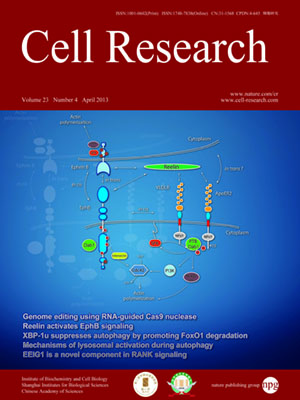
Volume 23, No 4, Apr 2013
ISSN: 1001-0602
EISSN: 1748-7838 2018
impact factor 17.848*
(Clarivate Analytics, 2019)
Volume 23 Issue 4, April 2013: 537-551
ORIGINAL ARTICLES
A trans-spliced telomerase RNA dictates telomere synthesis in Trypanosoma brucei
Ranjodh Sandhu1, Samantha Sanford2, Shrabani Basu2, MinA Park2, Unnati M Pandya1, Bibo Li 1 and Kausik Chakrabarti2
1Cleveland State University, Center for Gene Regulation in Health and Disease, Department of Biological, Geological, and Environmental Sciences, Cleveland, OH 44115, USA
2Carnegie Mellon University, Center for Nucleic Acids Science and Technology, Department of Chemistry, Pittsburgh, PA 15213, USA
Correspondence: Kausik Chakrabarti, Bibo Li(kausik@cmu.edu; libibo@gmail.com)
Telomerase is a ribonucleoprotein enzyme typically required for sustained cell proliferation. Although both telomerase activity and the telomerase catalytic protein component, TbTERT, have been identified in the eukaryotic pathogen Trypanosoma brucei, the RNA molecule that dictates telomere synthesis remains unknown. Here, we identify the RNA component of Trypanosoma brucei telomerase, TbTR, and provide phylogenetic and in vivo evidence for TbTR's native folding and activity. We show that TbTR is processed through trans-splicing, and is a capped transcript that interacts and copurifies with TbTERT in vivo. Deletion of TbTR caused progressive shortening of telomeres at a rate of 3-5 bp/population doubling (PD), which can be rescued by ectopic expression of a wild-type allele of TbTR in an apparent dose-dependent manner. Remarkably, introduction of mutations in the TbTR template domain resulted in corresponding mutant telomere sequences, demonstrating that telomere synthesis in T. brucei is dependent on TbTR. We also propose a secondary structure model for TbTR based on phylogenetic analysis and chemical probing experiments, thus defining TbTR domains that may have important functional implications in telomere synthesis. Identification and characterization of TbTR not only provide important insights into T. brucei telomere functions, which have been shown to play important roles in T. brucei pathogenesis, but also offer T. brucei as an attractive model system for studying telomerase biology in pathogenic protozoa and for comparative analysis of telomerase function with higher eukaryotes.
Cell Research (2013) 23:537–551. doi:10.1038/cr.2013.35; published online 12 March 2013
FULL TEXT | PDF
Browse 2266


